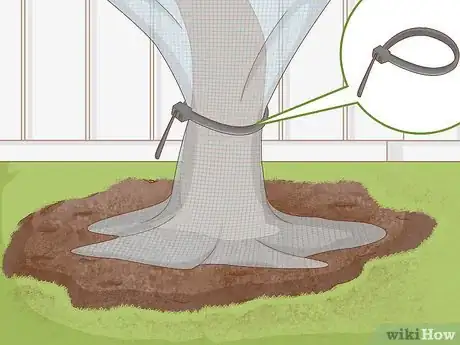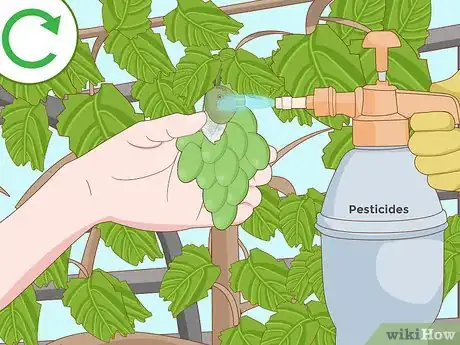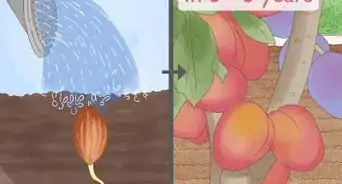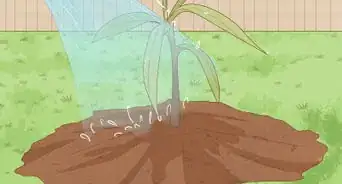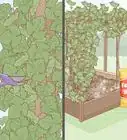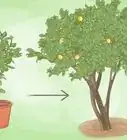This article was co-authored by Lauren Kurtz. Lauren Kurtz is a Naturalist and Horticultural Specialist. Lauren has worked for Aurora, Colorado managing the Water-Wise Garden at Aurora Municipal Center for the Water Conservation Department. She earned a BA in Environmental and Sustainability Studies from Western Michigan University in 2014.
There are 10 references cited in this article, which can be found at the bottom of the page.
This article has been viewed 30,423 times.
If you are growing grapes in your home garden or small vineyard, you may want to protect them from insects that may damage or completely destroy your crops. The good news is that grape vines can withstand low to moderate levels of insect damage, in which case garden netting can be an effective option. In the unlikely case that you have a severe insect infestation, you may need to consider applying a pesticide. While it is impossible to completely protect your grape vines against pests, it is possible to control them.
Steps
Using Insect Netting
-
1Cover your grape vines with fine mesh netting to protect the grapes. The mesh should be between 0.5 to 0.8 millimetres (0.020 to 0.031 in) to protect the grapes from flies, moths, beetles, and other larger insects. The mesh creates a barrier and reduces the need to use chemicals.[1]
- Mesh netting also protects your grapes from birds and small mammals that could be pests.
- Sunlight and water can still penetrate the netting, so there is no need to worry about removing it to care for your vines.[2]
-
2Cut a section from the roll of mesh large enough to wrap around the entire vine. Eye your vines to get the approximate size you need, and then add an extra .3 metres (0.98 ft) or so for good measure. Having a section that is too big would be better than cutting a section that is too small and cannot be used.
- The mesh should be large enough to completely cover the tops of the vine and secure tightly at the trunk.[3]
Advertisement -
3Drape the mesh netting over the tops of the vine. Pull the netting down over all of the leaves and branches, and wrap it around the bottom of the vine near the trunk. It may be helpful to have a partner assist with this part, especially for larger vines.
- Make sure all leaves, fruit, and branches are covered.
-
4Secure the mesh netting on the trunk of the grape vine using zip ties. Hold the netting in place with one hand. With the other hand, or with the help of a partner, wrap the zip tie around the mesh on the trunk, slide the tail end of the zip tie through the head, and pull it tight.
- For vines that are growing alongside a wooden fence or structure, you can cover the vines with the netting from the side, and attach it to the nearby structure using a small staple gun.
-
5Place mesh bags over individual grape bunches if you have fewer vines. The bags come in many different sizes and counts, but can be purchased for as little as $20.00 USD for 100 bags online or at your local home and garden store.[4]
- Simply place the drawstring bag over a grape bunch and pull the strings to tighten and close the bag.
- Alternatively, try placing brown paper lunch bags over a cluster of grapes and stapling it shut.[5] This is an easy, affordable option for grapes that have grown to size and are near ripening.
Applying Pesticides
-
1Observe your grapes to determine the type of insect infestation you have. This can vary depending on your geographical location or the climate. Become familiar with the types of pests present in your area to help you identify which ones are causing your issue.[6] You will need to know the specific insects because many insecticides are only effective against certain types of pests.
- For instance, the grape berry moth is a common pest found in the northeastern United States. The insecticides Intrepid or Sevin are rated as highly effective in controlling them, but Assail is not effective at all.
- Assail is effective, though, in controlling leafhoppers, which are prominent pests in California and the western United States.[7]
-
2Find a home and garden pesticide specific to your type of insect. You will need to read the labels to be sure you get the right product. For instance, if you’ve determined that your insect problem is from the grape berry moth, you will need a product that specifically states that it is effective in controlling grape berry moths.[8]
- Some products, like Home Orchard Spray, aim to control a variety of common grape vine pests including the grape berry moth, Japanese beetle, and rose chafers. A broad-scope product may be a good option if you have multiple types of pests and/or haven’t been able to identify the specific type of insect affecting your vines.[9]
- Pesticides typically range from $10.00 - $20.00 USD and can be purchased as a concentrate that needs to be mixed with water, or as a ready-to-use spray.
- Read the label thoroughly before you use a pesticide.
- Wear gloves and goggles while you spray so you don’t come into contact with any chemicals.
- Some pesticides are not safe for consumption so make sure to follow the label directions. Don’t let pets or people near grapes you’ve sprayed until the amount of time passes as recommended.
-
3Use neem oil to protect your grapes from insects naturally. There are many organic pesticides that contain neem oil. The products are available as a dust, wettable powder, or a concentrate to be mixed with water.[10] Check online or at your local home and garden store to find a product that fits your needs.
- Neem oil should not be applied to table grapes after they have bloomed, so apply it to the vines early in the season for the best results.[11]
-
4Apply the pesticide to your grape vines. Follow the instructions on the label. Some products require certain temperatures to be effective, a waiting period before the grapes can be consumed, and some should only be applied during certain growing stages—for instance, not when the fruit is blossoming.[12]
- Reapply the pesticide as needed and as directed on the product label.
- Be sure to wear protective gear like gloves and safety glasses when applying chemicals.
Community Q&A
-
QuestionWhen is the best time to apply insect spray to the vine tree?
 Konstantin BukarevCommunity AnswerApply the spray when the plant or actual grapes mature to about 2-3 years. That is when the plant is reaching adulthood and is most vulnerable to pests.
Konstantin BukarevCommunity AnswerApply the spray when the plant or actual grapes mature to about 2-3 years. That is when the plant is reaching adulthood and is most vulnerable to pests. -
QuestionWasps are eating and destroying my quarter acre of grapes, first time. Any suggestions to save my crop?
 Konstantin BukarevCommunity AnswerRegarding wasps, you could consider spraying the plants with B.T (a bacteria that kills insects such as wasps but leaves non harmful insects such as bees alone). If that fails, try covering the plants with a mesh screen.
Konstantin BukarevCommunity AnswerRegarding wasps, you could consider spraying the plants with B.T (a bacteria that kills insects such as wasps but leaves non harmful insects such as bees alone). If that fails, try covering the plants with a mesh screen. -
QuestionWhat pest curls the leaf with webbing?
 Konstantin BukarevCommunity AnswerLeaf curl aphid or leaf curling spider are the likely suspects here. The leaf curling aphid is a pest, while the leaf curling spider eats other insects.
Konstantin BukarevCommunity AnswerLeaf curl aphid or leaf curling spider are the likely suspects here. The leaf curling aphid is a pest, while the leaf curling spider eats other insects.
References
- ↑ https://deepgreenpermaculture.com/2017/03/09/netting-fruit-trees-for-pest-control/
- ↑ https://www.youtube.com/watch?v=IIfEfM2W0Ss
- ↑ https://books.google.com/books?id=6Xh35zXiNWYC&pg=PA328&lpg=PA328&dqg&sig=5RMcxmJofc1cRVoFT3tCJk5MMtw&hl=en&sa=X&ved=0ahUKEwin9sSYkvDaAhVP8mMKHbHzDQE4ChDoAQhNMAY#v=onepage&q&f=false
- ↑ https://www.youtube.com/watch?v=9hsdH688_Es
- ↑ http://images.library.wisc.edu/WI/EFacs/USAIN/WSHS/WSHS1884/reference/wi.wshs1884.i0058.pdf
- ↑ http://msue.anr.msu.edu/uploads/files/e2698.pdf
- ↑ http://ipm.ucanr.edu/PMG/GARDEN/FRUIT/grapes.html
- ↑ http://ipm.ucanr.edu/PMG/GARDEN/FRUIT/grapes.html
- ↑ http://ipm.ucanr.edu/PMG/GARDEN/FRUIT/grapes.html



